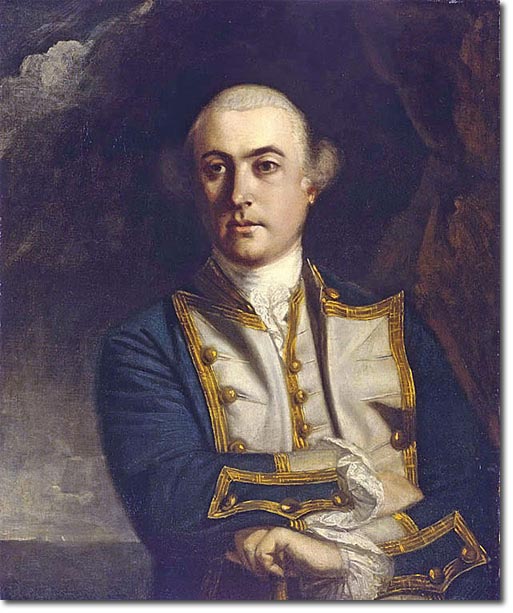|
|


|
|
Anson's circumnavigation of 1740-44 had had the effect of renewing British interest in the South Atlantic and the Pacific. In 1749 Lord Sandwich, first lord of the Admiralty, put forward a plan, probably suggested by Anson, to send British ships to the Falkland Islands and then into the Pacific. After reaching the Juan Fernandez Islands they were to head due west for 3000 miles across the ocean, searching for islands or other undiscovered land. The hope was to find a base from which Britain could break into Spanish trade in the Pacific. Preparations for this expedition were carried out openly and details soon reached the Spanish. They protested strongly and since the British government was at this time trying to negotiate a trade treaty with Spain, it decided to cancel the expedition to appease the Spanish.
After Lord Egmont became first lord of the Admiralty he decided in 1764 to carry out a modified version of the 1749 plan; his principal interest at this time was in securing British command of the Falkland Islands, which he regarded as controlling the southern gateway to the Pacific. Since the Spanish claimed ownership of the Falklands and would object to any revival of the 1749 plan, Egmont prepared the expedition in some secrecy. Only the Admiralty and George III knew its true aims, with most members of the government being kept in the dark. Byron was chosen to command the expedition, which consisted of the frigate Dolphin, one of the first British warships with a copper-sheathed bottom, and the sloop Tamar. It was given out that Byron was going out to take command of the East India station, and would fly the broad pennant of a commodore in the Dolphin. Byron left England in July 1764, and took his ships to Brazil. Only when leaving Rio de Janeiro on 22 October did he reveal his secret orders to his men. The plan was that they would first go into the south Atlantic and search for Pepys's Island, and then to the Falkland Islands. After they had been claimed for Britain, Byron was to proceed into the Pacific, sail to New Albion (California), and then begin a search for the north-west passage, leading back to the Atlantic across the top of North America. If the passage could not be found Byron was to come home across the Pacific. From Rio Byron went first to Port Desire in Patagonia. Here he met tall natives and noted their existence in his journal. When John Hawkesworth brought out a somewhat romanticized version of Byron's circumnavigation journal in 1773 he greatly exaggerated the size of these natives, and this led to much levity at Byron's expense concerning Patagonian giants. From Port Desire Byron headed out into the south Atlantic searching for Pepys's Island, which had been noted on earlier charts. When it became clear that the island did not exist Byron sailed for the Falklands. In January 1765 Byron reached West Falkland and anchored at a place he named Port Egmont after the first lord. Byron then formally claimed the islands for George III, and explored along the north coasts of both West and East Falkland. His cursory inspection failed to find the French settlement which had recently been established at Berkeley Sound on East Falkland. For the rest of the decade Britain, France, and Spain would engage in a three-cornered dispute about the ownership of the Falklands. For the moment Byron left the islands and returned to Port Desire to meet a storeship that was bringing supplies for his ships. Once resupplied Byron took his ships through the Strait of Magellan, but once in the Pacific in April 1765 he decided to ignore his orders to search for the north-west passage. Instead Byron intended to cross the Pacific following a track between the tropic of Capricorn and the equator. He was never censured for this clear breach of his written orders, possibly because it was a reversion to part of the 1749 plan. Byron intended to look for islands along this track, in particular the Solomon Islands and their fabled riches. These islands had been first discovered in the Sixteenth Century, but their exact position and extent had never been established. In fact Byron found very few islands during his voyage across the Pacific, and none of importance. After finding several small islands in the Tuamotu group but being unable to anchor at them, Byron called them the Islands of Disappointment; some small islands found later were called the King George Islands; and another island found in the Gilbert group Byron named after himself. Byron narrowly missed sighting Tahiti, but he did claim to have seen signs which indicated the existence of a southern continent. At the end of July 1765 Byron's ships reached Tinian in the Marianas, which had been visited by Anson during his voyage, and then they set off on their homeward passage. On his arrival in England in May 1766 Byron was able to claim the fastest circumnavigation up to that time; his men were relatively untouched by scurvy, while the Dolphin's copper-sheathed bottom survived the voyage in good condition, an important advance in naval technology. Byron's mention of signs of a southern continent encouraged the immediate preparation of another expedition to the Pacific, and Byron may have had a hand in preparing the instructions to its commander, Captain Wallis. He was specifically ordered to search for the southern continent, but it was to prove elusive. However, by following a track similar to Byron's, but further to the south, Wallis did discover Tahiti in 1767. |
Falkland Islands | Falkland Island Administrators
Armed Forces | Art and Culture | Articles | Biographies | Colonies | Discussion | Glossary | Home | Library | Links | Map Room | Sources and Media | Science and Technology | Search | Student Zone | Timelines | TV & Film | Wargames